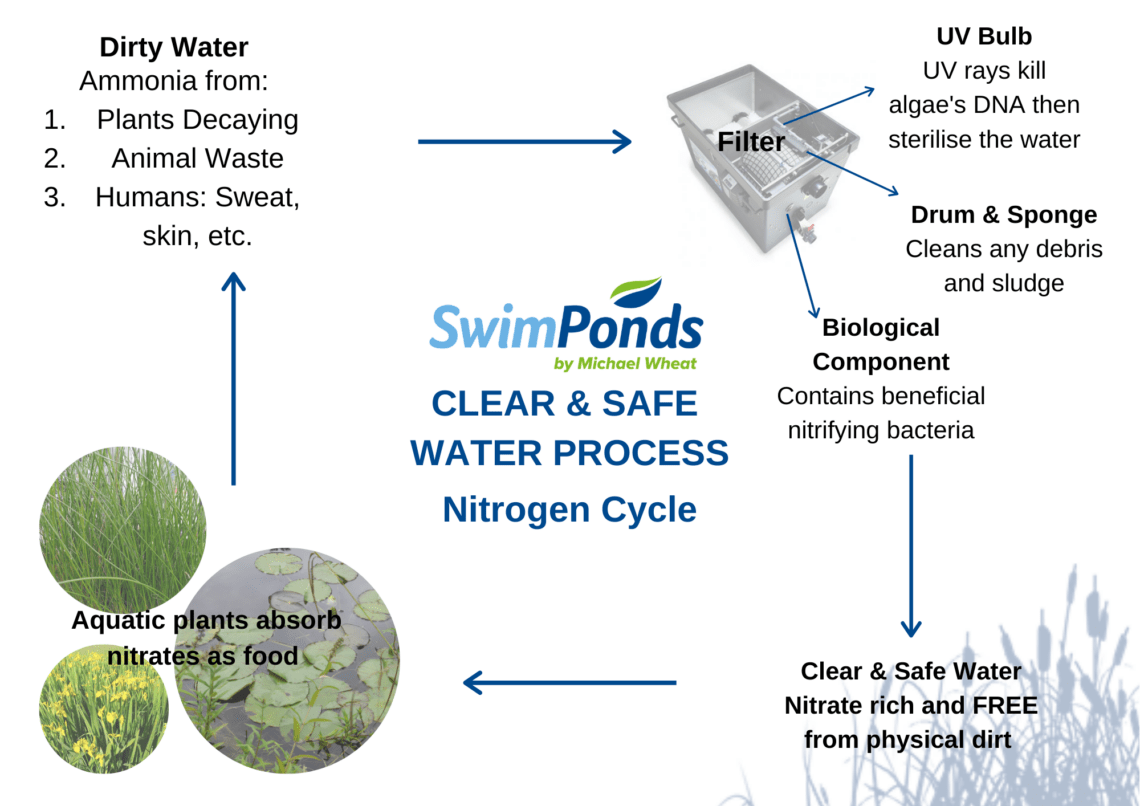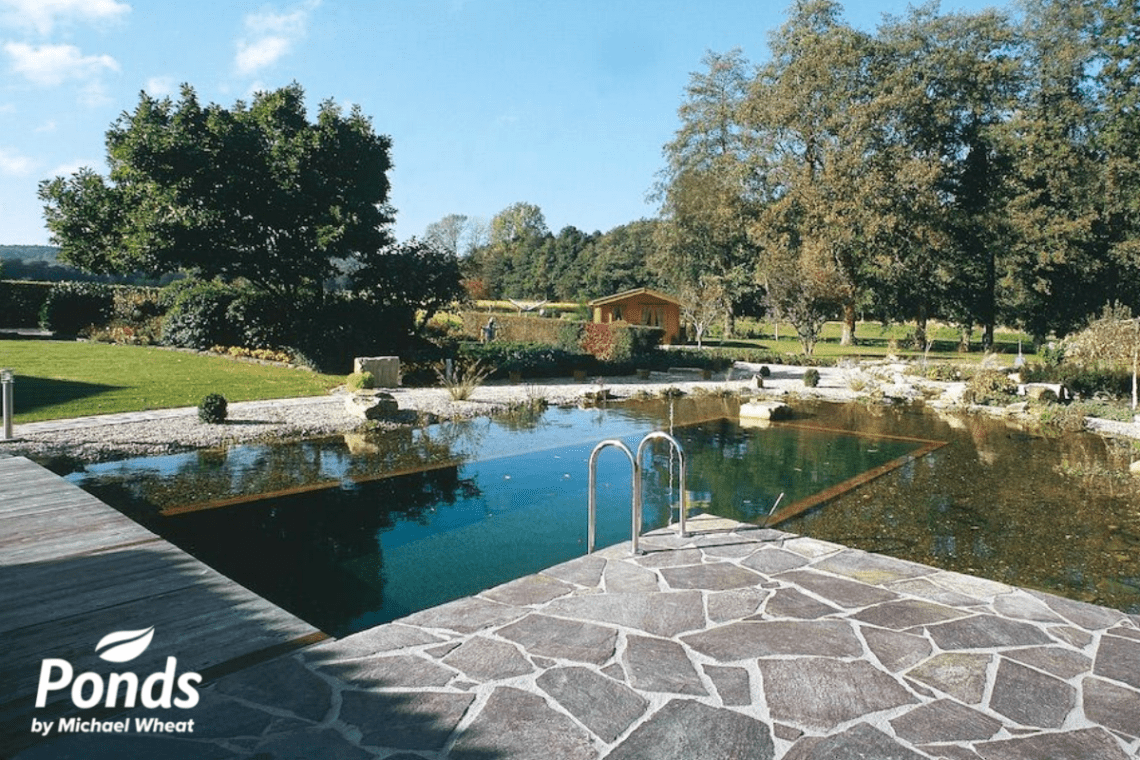Swimpond filtration can seem a bit complicated; the different types of filtration specified depend on the size of the project and location the pond is being installed.
Here, we thought it was important to talk about natural pond filtration and how at Ponds by Michael Wheat we work to design a sustainable pond that you can enjoy year after year.
Key Takeaways
- Natural swimming pond filtration mimics nature’s own purifying methods.
- A balanced pond ecosystem is crucial for clarity and water quality.
- Thoughtful design will minimise the need for a mechanical filter, maintaining a natural aesthetic.

Did You Know That In A Swimpond, Filtration Is Essential?
Whether that is natural filtration through pond plants and gravel or a biological filter – it is imperative to consider the water’s nutrient balance to keep the water crystal clear.
Biological Filtration Installation
We design and build our freshwater swimming ponds to maintain a state of natural balance. Biological filters with biomedia provide the perfect support to help harness nature’s natural processes.
The fundamental principle of a swimming pond is that no chemicals are needed, and fresh water filtration is installed that moves the water around, through plant beds, past UV light and through the biological filter box so the pond essentially cleans itself.
We design and build natural swimponds that use the purifying elements of micro-organisms inside the filter with plants to sustain clear, healthy, and clean water.
Nutrient Balance

Ponds by Michael Wheat fit a range of filters. In nature, the whole pond edge and plants act as a filter. The microscopic life-forms in the gravel and clay at the pond’s edge effectively filter the water as it passes through.
However, it’s not quite that simple when the pond is man made. We do need to give nature a helping hand. In swimming ponds, we have to keep the nutrient levels low. We manage this by using a small pump to circulate the water through the filtration units. The filter has a UV bulb, all the water is pumped past these UV rays.
Doing this enables us to control the algae, hence preventing the growth of blanket weed (string algae). Plants also help by absorbing nutrients from the water. By controlling the nutrients in this way, algae won’t flourish, and the result is beautiful, healthy, clean and clear swimming water!
The construction of your freshwater swimming pond will be to the very highest standards of hygiene.
Understanding Natural Swimming Pond Filtration

In transitioning to natural ponds, you’ll find that the key to crystal-clear water lies in a well-engineered, ecological filtration system that creates natural balance without reliance on chemicals.
Concept of Natural Filtration
Natural swimming ponds use biological filtration systems that mimic the cleaning functions of natural ecosystems. In your pond, beneficial bacteria play a vital role; these bacteria break down organic waste and excess nutrients in the pond water, significantly reducing the potential for algae blooms. Through this natural filtration process, the pond water remains clean and clear, all without the use of traditional pool chemicals like chlorine.
The Ecosystem Approach

In a natural swimming pond, the maintenance of clear pond water is achieved through a harmonious ecological balance, along with the use of mechanical and biological filters to keep your pond naturally clean. This involves segregating the pond into two major zones: one for swimming and one dedicated to the ecological filtration.
In the filtration zone, a diverse array of pond plants serves as living pond filters, further enhancing water quality. This natural setup encourages the propagation of beneficial microorganisms that contribute to this chemical-free water system, resulting in a clean and healthy pond.
Comparison with Traditional Swimming Pool Systems
Traditional pools rely heavily on chemical agents such as chlorine to keep the water clean, which can have effects on your skin and eyes. In contrast, a chlorine-free, natural swimming pond uses natural processes to purify water, offering a swimming experience that’s gentle on both your body and the environment.
With a biological filtration unit in place, these systems can maintain clear water much like their chemically-treated counterparts, but they do so by delivering a toxic-free swimming environment where a naturally balanced pond is the norm.
By understanding the mechanics behind biological pond filtration, you can fully appreciate the ecological advantages and purity of the waters you immerse yourself in.
Selecting Native Plants
Choosing the right plants is key to a successful filtration system. Opt for native plants which are adapted to local conditions and can better support local wildlife. Native species tend to be hardier and require less maintenance.
By establishing a diverse array of plants, you can boost biodiversity, with each species fulfilling a unique role within the pond’s ecosystem. Implement plants that support not only filtration but also provide habitat for beneficial insects to thrive.
Maintaining Water Quality and Clarity

Achieving crystal-clear water in your natural swimming pond hinges on effective algae management and maintaining the right balance of nutrients. Regular water testing and timely adjustments are imperative to ensure optimal conditions for swimming and aquatic life.
Algae Control and Nutrient Balance
Algae in your pond can be controlled by managing nutrients, as these are the primary food source for algae growth. You need to ensure a balance between the amount of sunlight your pond receives and the levels of phosphates and nitrates, which can lead to excessive algae and green water if unregulated.
Biodiversity is crucial; promoting a variety of plant life can naturally reduce nutrient levels. Consider aquatic plants that have natural filtration abilities. Also, mechanical solutions like UV clarification help by disrupting algae’s ability to reproduce. Aeration is equally important, as it increases oxygen levels, reducing the likelihood of algae blooms.
- Sunlight Exposure: Limit sunlight to prevent overgrowth of algae.
- Plant Life: Introduce aquatic plants that compete with algae for nutrients.
- Oxygenation: Use waterfalls and aeration systems to enhance water movement and oxygen levels on both the surface and bottom of the pond.
Water Testing and Adjustments
Regular water testing is essential to monitor the pH levels, alkalinity, and overall pond water quality. Keeping the pH levels below 0.035 promotes a healthy environment for your pond’s ecosystem. If tests indicate an imbalance, you may need to make adjustments using products that raise or lower pH levels carefully.
- pH Levels: Test weekly to maintain a neutral pH.
- Alkalinity: Aim for an alkalinity level that supports a stable pH.
To maintain water clarity, remove organic matter such as leaves, dirt and fish waste with a pond skimmer or pond vacuum. Remember that good water movement helps prevent the settlement of particles and contributes to clearer water.
Enhance Your Garden with Eco-Friendly Pond Solutions

Embracing these eco-friendly methods not only beautifies your garden but also supports a healthier ecosystem. Ready to enhance your pond with natural solutions?
Explore our pond maintenance packages for expert support, or contact us directly at Ponds by Michael Wheat. Let us help you achieve a perfectly balanced and naturally filtered pond. Dive into clear waters today – your pond’s natural beauty awaits.
Frequently Asked Questions
1. Can a pond be adequately filtered to meet swimming standards using a biological filtration method?
Yes, a pond can meet swimming standards using organic pond filter systems because the use of multiple biological filters, such as bog gravel filtration and plants, are highly effective at cleansing water. It’s essential that the system is correctly sized to handle the pond volume and swimmer load to keep your natural pond clean.
2. Can swimponds function during winter?
Swimponds are designed to operate year-round. The natural pond filtration systems continue to run during winter, maintaining low nutrient levels and preventing algae growth. You may need to carry out pond winterisation prior to the start of winter, depending on your location.
Top Tip: Check out our guide 5 Top Reasons Why Winter Is The Best Time For a SwimPond
3. Are swimponds energy-efficient?
Compared to traditional swimming pools, swimponds are often more energy-efficient. They require less electrical power as a natural ecosystem pond performs much of the water cleansing and circulation processes, supplemented by strategically used pond pumps and UV systems.
4. What types of plants are best for swim pond filtration?
Ideal plants for filtration include water lilies, iris, and reed plants. These not only help purify the water but also enhance the natural beauty of the pond.
5. Can swim ponds be heated, and how does this affect filtration?
Yes, swim ponds can be heated. Heating swimming ponds can affect filtration by altering the growth rates of plants and the activity levels of microbial populations. It’s important to adjust maintenance practices accordingly to maintain water quality.